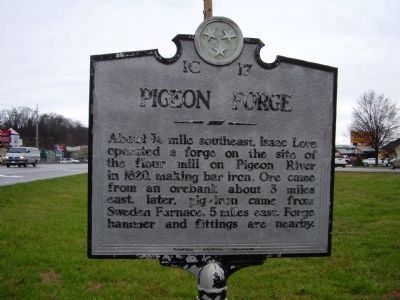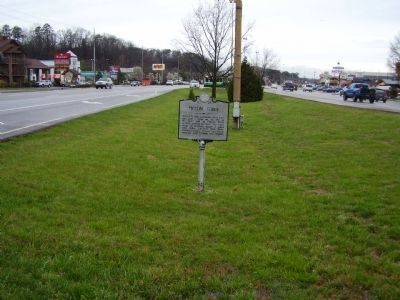Pigeon Forge in Sevier County, Tennessee — The American South (East South Central)
Pigeon Forge
Erected by Tennessee Historical Commission. (Marker Number 1C-17.)
Topics and series. This historical marker is listed in this topic list: Industry & Commerce. In addition, it is included in the Tennessee Historical Commission series list. A significant historical year for this entry is 1820.
Location. 35° 46.563′ N, 83° 32.627′ W. Marker is in Pigeon Forge, Tennessee, in Sevier County. Marker is on The Great Smoky Mountains Highway (U.S. 441), in the median. Touch for map. Marker is at or near this postal address: 4010 Parkway, Pigeon Forge TN 37863, United States of America. Touch for directions.
Other nearby markers. At least 8 other markers are within walking distance of this marker. Pigeon Forge Attractions (about 500 feet away, measured in a direct line); Broady Dairy (approx. 0.2 miles away); Pigeon River Railroad (approx. ¾ mile away); First Baptist Church Pigeon Forge (approx. ¾ mile away); First United Methodist Church of Pigeon Forge and Pigeon Forge Academy (approx. ¾ mile away); Pigeon Forge Elementary School / Pigeon Forge Canning Factory (approx. 0.9 miles away); Sevier County Veterans Memorial (approx. one mile away); Pigeon Forge Iron Works (approx. one mile away). Touch for a list and map of all markers in Pigeon Forge.
Regarding Pigeon Forge. The West Fork of the Little Pigeon River flows north from its source high on the slopes of Mount Collins through Sevier County before linking up with the Middle Fork in Sevierville. Pigeon Forge occupies a narrow valley along this river between Sevierville and Gatlinburg. High ridges surround Pigeon Forge on three sides, with Pine Mountain to the west, Shields Mountain to the east, and Cove Mountain to the south. A bend in the Little Pigeon provides the city's northern border with Sevierville, and a narrow gorge cut by the river between Cove Mountain and Shields Mountain acts as the city's buffer with Gatlinburg.
Additional commentary.
1. The Forge
The Forge part of the name comes from a booming ‘forge’ built in 1817 by Isaac Love. This was a site near the present Old Mill. With its first business being iron and furnace forge, Pigeon Forge has progressed 10 fold from pioneer town to profitable town Sitting on land that was once Cherokee hunting Ground, a 1700’s treaty opened the valley up for settlement. Mordecai Lewis was a Pigeon Forge pioneer who received a 151-acre land grant and built the now historic Old Mill around 1790. In 1849, the mill (or forge tract) was purchased by Mr. John Sevier Trotter who sold it to Mr. John Marshall McMahan. Mr. John Marshall McMahan sold one fourth of the mill interest to A.T. Householder in December of 1900. His transfer deed mentioned a sawmill, gristmill and a carding machine. The Forge that gave Pigeon Forge its name was dismantled sometime before 1884. Some believe it was moved to Kentucky. The five hundred pound hammer used in the forge was preserved. The hammer was displayed at the Forge Hammer Grill owned and operated by Henry and Fannie Butler. Forge Hammer Grill later became Butler’s Farm Restaurant and, finally, the Apple Tree Inn. For years, a live apple tree grew inside the dining area of the restaurant. It was first owned by Dick and Mildred Bunting and is now in the hands of Garnett Cole and her son Kyle. The forge’s hammer continued to remain on display at the Apple Tree Inn for many years. It is still in the possession of the Cole Family.
— Submitted June 19, 2009, by Stanley and Terrie Howard of Greer, South Carolina.
Credits. This page was last revised on June 16, 2016. It was originally submitted on March 22, 2009, by Stanley and Terrie Howard of Greer, South Carolina. This page has been viewed 1,651 times since then and 41 times this year. Last updated on April 21, 2015, by J. Makali Bruton of Accra, Ghana. Photos: 1, 2. submitted on March 22, 2009, by Stanley and Terrie Howard of Greer, South Carolina. • Andrew Ruppenstein was the editor who published this page.

